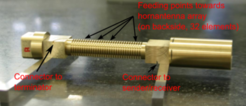Highlights 2012
Research news from the division Plasma Edge and Wall
New "Helmholtz Virtual Institute" entitled "Plasma Dynamical Processes and Turbulence Studies using Advanced Microwave Diagnostics" approved
The Virtual Institute (VI) is positioned strategically centrally between basic research in the field of plasma dynamics with relevance for a wide range of topics, specific research on turbulence in fusion plasmas, as well as the development of new kinds of microwave diagnostics for such investigations, which will also feature inherent advantages in the application in future fusion devices. With partners from various disciplines – universities and research institutes – the VI forms an internationally outstanding competence centre for microwave technology, its application as a diagnostic, and for the interpretation of the data with respect to plasma turbulence.
Plasma dynamical processes do not only play a central role in fusion, but also in extraterrestrial and astrophysical research. Experimental investigations of theoretical models, which can be performed in high temperature plasmas of existing fusion experiments, will be intensified by the VI. Central questions of fusion research, like the turbulent transport and transport barriers, will thereby be investigated. For the development of the appropriate microwave diagnostics the VI includes university institutes with a focus on electro-technical engineering. The expertise for the application of components and for the evaluation and interpretation of the acquired data is provided by the national and international partners participating in the VI. Based on their good functionality under high radiation levels the diagnostics developed within the VI will be among the important diagnostic possibilities for the observation and control of thermonuclear plasmas in future fusion experiments.
The VI will be funded for 4 to 5 years and led by E2M. The partners are Forschungszentrum Jülich, the Institut für Plasmaforschung of the University of Stuttgart, the Institute for High-Frequency Engineering of TU München, LPP Ecole Polytechnique, France, and Ecole Polytechnique Fédérale de Lausanne, Switzerland.

